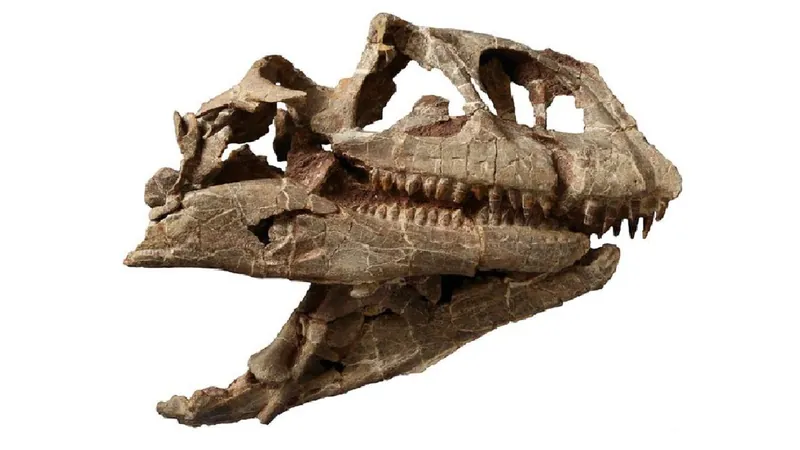
Unearthed Giant Dinosaur Skull in China: Uncovering a 200-Million-Year-Old Mystery!
2025-01-13
Author: Ken Lee
Discovering Lishulong wangi
A remarkable discovery has captured the attention of the paleontological world: an exceptionally preserved skull belonging to a previously unknown dinosaur species has been uncovered in China, researchers announce. This colossal specimen, affectionately named Lishulong wangi, hails from the Early Jurassic period, approximately 200 million years ago.
Findings in the Lufeng Dinosaur National Geopark
The enormous skull was found in 2007 within the Lufeng Dinosaur National Geopark in Yunnan Province, Southern China. Researchers believe this early relative of the sauropods—those iconic long-necked giants like Brontosaurus and Diplodocus—could grow to an impressive length of up to 33 feet (10 meters).
Significance of Lishulong wangi
What makes L. wangi stand out? According to the recent publication in the journal PeerJ, dated December 12, 2024, this species is likely the largest non-sauropod sauropodomorph excavated from the Lufeng Formation, known for its bounty of early sauropodomorph fossils, boasting the discovery of seven other genera.
Fossilization Process and Preservation
The unique geological conditions of the region played a crucial role in the fossilization process. Lead researcher Qian-Nan Zhang, a paleontologist from the Institute of Vertebrate Paleontology and Paleoanthropology at the Chinese Academy of Sciences, emphasized how the finely grained sediment, rich in clays, sand, and silt from ancient lakes and rivers, helped shield the remains from erosion. This environment allowed minerals to permeate the bone structure, resulting in an exquisite level of preservation seldom seen in sauropodomorphs—despite the skull being compressed by overlying sediments, most cranial bones remained intact.
Ecological Role of Non-Sauropod Sauropodomorphs
Interestingly, non-sauropod sauropodomorphs were the dominant medium to large herbivorous dinosaurs until the Middle Jurassic, showcasing a versatility that allowed them to walk on their hind legs. These early dinosaurs share a common ancestor with theropods, like the formidable Tyrannosaurus rex, maintaining a bipedal stance.
Diet and Lifestyle of Lishulong wangi
The new fossil discovery consists of the dinosaur's skull and nine cervical vertebrae. Zhang pointed out the absence of shoulder and pelvic girdle bones, leaving questions about whether L. wangi was primarily bipedal or quadrupedal. However, its closest relative, the Yunnanosaurus, is thought to have been capable of both stances, hinting that L. wangi might have shared this adaptability.
Diet and Environmental Interactions
What did L. wangi eat? Zhang theorized that its diet likely consisted of gymnosperms and other primitive plant types, including ferns, cycads, ginkgos, and conifers, echoing the herbivorous traits of its kind. Based on observations of the fusion of skeletal elements and overall size, this specimen is believed to have reached maturity before its death, hinting at a complex life amidst ancient ecosystems.
The Mystery of Lishulong wangi's Demise
However, the mystery surrounding its demise remains unsolved. The preservation of only the skull and cervical vertebrae indicates that the remains may have experienced some form of transportation post-mortem, complicating the determination of how this remarkable creature met its end.
Conclusion and Future Research
In a realm where every fossil holds a story, Lishulong wangi gives us a glimpse into a prehistoric world teeming with life and diversity. Stay tuned as researchers continue to unveil the secrets of this gigantic dinosaur and its ancient habitat!


 Brasil (PT)
Brasil (PT)
 Canada (EN)
Canada (EN)
 Chile (ES)
Chile (ES)
 Česko (CS)
Česko (CS)
 대한민국 (KO)
대한민국 (KO)
 España (ES)
España (ES)
 France (FR)
France (FR)
 Hong Kong (EN)
Hong Kong (EN)
 Italia (IT)
Italia (IT)
 日本 (JA)
日本 (JA)
 Magyarország (HU)
Magyarország (HU)
 Norge (NO)
Norge (NO)
 Polska (PL)
Polska (PL)
 Schweiz (DE)
Schweiz (DE)
 Singapore (EN)
Singapore (EN)
 Sverige (SV)
Sverige (SV)
 Suomi (FI)
Suomi (FI)
 Türkiye (TR)
Türkiye (TR)
 الإمارات العربية المتحدة (AR)
الإمارات العربية المتحدة (AR)